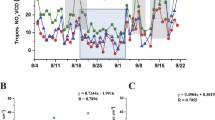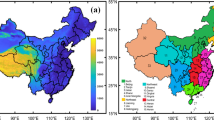Abstract
Control policies such as “odd-and-even license plate rule” were implemented by the Chinese government to restrict traffic and suspend factory production in Beijing and neighboring cities during the Asia-Pacific Economic Cooperation summit. We use ozone monitoring instrument (OMI), mobile differential optical absorption spectroscopy (DOAS), and multi-axis differential optical absorption spectroscopy (MAX-DOAS) to measure the variation of the spatial and temporal patterns of NO2 column densities from October 24, 2014 to November 22, 2014. It is found that the NO2 column densities during the episode of control policies are significantly lower than those during other periods, and the emission flux of NO2 calculated by mobile DOAS is also lower than the results from other periods. Some daily low NO2 column densities occur with the northwest wind direction. We then compare the relationship between OMI and mobile DOAS NO2 column density observations, and the results of mobile DOAS are approximately 2.7 times larger than the OMI values. The largest discrepancy occurs in the northern part of Beijing city. In other parts, the two instruments have a better correlation coefficient (R 2) of 0.61. The low NO2 column densities that occur during the episode of control policies are affected by the control policies as well as meteorological conditions.
Similar content being viewed by others
References
Seinfeld JH, Pandis SN. Atmospheric Chemistry and Physics: from Air Pollution to Climate Change. New York: John Wiley & Sons Inc, 1998. 234–330
Lelieveld J, Peters W, Dentener FJ, Krol M. Stability of tropospheric hydroxyl chemistry. J Geophys Res, 2002, doi: 10.1029/2002JD002272
EPA. Air quality index—A guide to air quality and your health. Washington: United States Environmental Protection Agency. 2000
Boersma KF, Jacob DJ, Trainic M, Rudich Y, DeSmedt I, Dirksen R, Eskes HJ. Validation of urban NO2 concentrations and their diurnal and seasonal variations observed from the SCIAMACHY and OMI sensors using in situ surface measurements in Israeli cities. Atmos Chem Phys, 2009, 9: 3867–3879
Molina MJ, Molina LT. Megacities and atmospheric pollution. J Air Waste Manage Assoc, 2004, 54: 644–680
Solomon S, Qin, D, Manning M, Chen Z, Marquis M, Averyt KB, Tignor M, Miller HL. Contribution of Working Group I to the Fourth Assessment Report of the Intergovernmental Panel on Climate Change. In: IPCC. Ed. Climate Change 2007: The Physical Science Basis. Cambridge: Cambridge University Press, 2007. 996
Wang YX, McElroy MB, Boersma KF, Eskes HJ, Veefkind JP. Traffic restrictions associated with the Sino-African summit: reductions of NOx detected from space. Geophys Res Lett, 2007, 34: L08814
Ma JZ, Beirle S, Jin JL, Shaiganfar R, Yan P, Wagner T. Tropospheric NO2 vertical column densities over Beijing: results of the first three years of ground-based MAX-DOAS measurements (2008–2011) and satellite validation. Atmos Chem Phys, 2013, 13: 1547–1567
Wu FC, Xie PH, Li A, Chan KL, Hart A, Wang Y, Si FQ, Zeng YM, Qin M, Xu J, Liu JG, Liu WQ, Wenig M. Observations of SO2 and NO2 by mobile DOAS in the Guangzhou eastern area during the Asian Games 2010. Atmos Meas Tech, 2013, 6: 2277–2292
Martin RV, Jacob DJ, Chance KV, Kurosu TP, Palmer PI, Evans MJ. Global inventory of nitrogen dioxide emissions constrained by spacebased observations of NO2 columns. J Geophys Res, 2003, 108: D17
van der ARJ, Eskes HJ, Boersma KF, van Noije TPC, van Roozendael M, de Smedt I, Peters DHMU, Meijer EW. Trends, seasonal variability and dominant NO x source derived from a ten year record of NO2 measured from space. J Geophys Res, 2008, 113: D04302
Beirle S, Boersma KF, Platt U, Lawrence MG, Wagner T. Megacity emissions and lifetimes of nitrogen oxides probed from space. Science, 2011, 333: 1737–1739
Russell AR, Valin LC, Bucsela EJ, Wenig MO, Cohen RC. Space-based constraints on spatial and temporal of NOx emissions in California, 2005–2008. Environ Sci Technol, 2010, 44: 3608–3615
Shaiganfar R, Beirle S, Sharma M, Chauhan A, Singh RP, Wagner T. Estimation of NOx emissions from Delhi using Car MAX-DOAS observations and comparison with OMI satellite data. Atmos Chem Phys, 2011, 11: 10871–10887
Li A, Xie PH, Liu WQ, Liu JG, Dou K. Studies on the determination of the flux of gaseous pollutant from an area by passive differential optical absorption spectroscopy. Spectrosc Spect Anal, 2009, 29: 28–32
Levelt PF, van den Oord GHJ, Dobber MR, Malkki A, Visser H, de Vries J, Stammes P, Lundell JOV, Saari H. The ozone monitoring instrument. IEEE Trans Geosci Rem Sens, 2006, 44: 1093–1101
Levelt PF, Hilsenrath E, Leppelmeier GW, van den Oord GHJ, Bhartia PK, Tamminen J, de Haan JF, Veefkind JP. Science objectives of the ozone monitoring instrument. IEEE Trans Geosci Rem Sens, 2006, 44: 1199–1208
Boersma KF, Eskes HJ, Veefkind JP, Brinksma EJ, van der ARJ, Sneep M, van den Oord GHJ, Levelt PF, Stammes P, Gleason JF, Bucsela EJ. Near-real time retrieval of tropospheric NO2 from OMI. Atmos Chem Phys, 2007, 7: 2103–2118
Bucsela EJ, Krotkov NA, Celarier EA, Lamsal LN, Swartz WH, Bhartia PK, Boersma KF, Veefkind JP, Gleason JF, Pickering KE. A new stratospheric and tropospheric NO2 retrieval algorithm for nadirviewing satellite instruments: applications to OMI. Atmos Meas Tech, 2013, 6: 2607–2626
Platt U. Differential optical absorption spectroscopy (DOAS), in air monitoring by spectroscopic techniques. Chem Anal, 1994, 127
Wenig MO, Cede AM, Bucsela EJ, Celarier EA, Boersma KF, Veefkind JP, Brinksma EJ, Gleason JF, Herman JR. Validation of OMI tropospheric NO2 column densities using direct-sun mode brewer measurements at NASA goddard space flight center. J Geophys Res, 2008, 113: D16
Johansson M, Galle B, Yu T, Tang L, Chen DL, Li HJ, Li JX, Zhang Y. Quantification of total emission of air pollutants from Beijing using mobile mini-DOAS. Atmos Environ, 2008, 42: 6926–6933
Rivera C, Sosa G, Wohrnschimmel H, de Foy B, Johansson M, Galle B. Tula industrial complex (Mexico) emissions of SO2 and NO2 during the MCMA 2006 field campaign using a mobile mini-DOAS system. Atmos Chem Phys, 2009, 9: 6351–6361
Xu J, Xie PH, Si FQ, Dou K, Li A, Liu Y, Liu WQ. Retrieval of tropospheric NO2 by multi axis differential optical absorption spectroscopy. Spectrosc Spect Anal, 2010, 30: 2464–2469
Ibrahim O, Shaiganfar R, Sinreich R, Stein T, Platt U, Wagner T. Car MAX-DOAS measurements around entire cities: quantification of NOx emissions from the cities of Mannheim and Ludwigshafen (Germany). Atmos Meas Tech, 2010, 3: 709–721
Author information
Authors and Affiliations
Corresponding author
Rights and permissions
About this article
Cite this article
Li, A., Zhang, J., Xie, P. et al. Variation of temporal and spatial patterns of NO2 in Beijing using OMI and mobile DOAS. Sci. China Chem. 58, 1367–1376 (2015). https://doi.org/10.1007/s11426-015-5459-x
Received:
Accepted:
Published:
Issue Date:
DOI: https://doi.org/10.1007/s11426-015-5459-x




